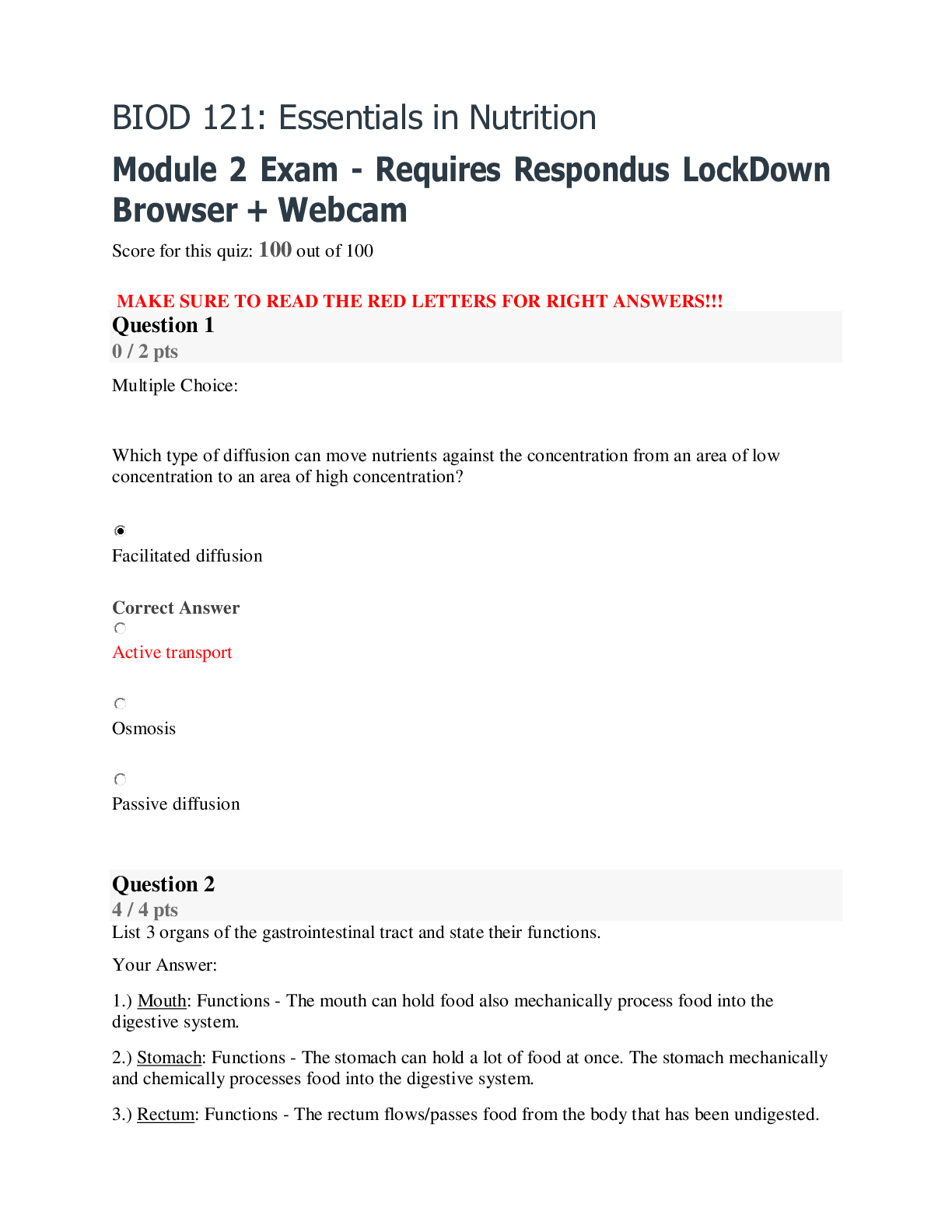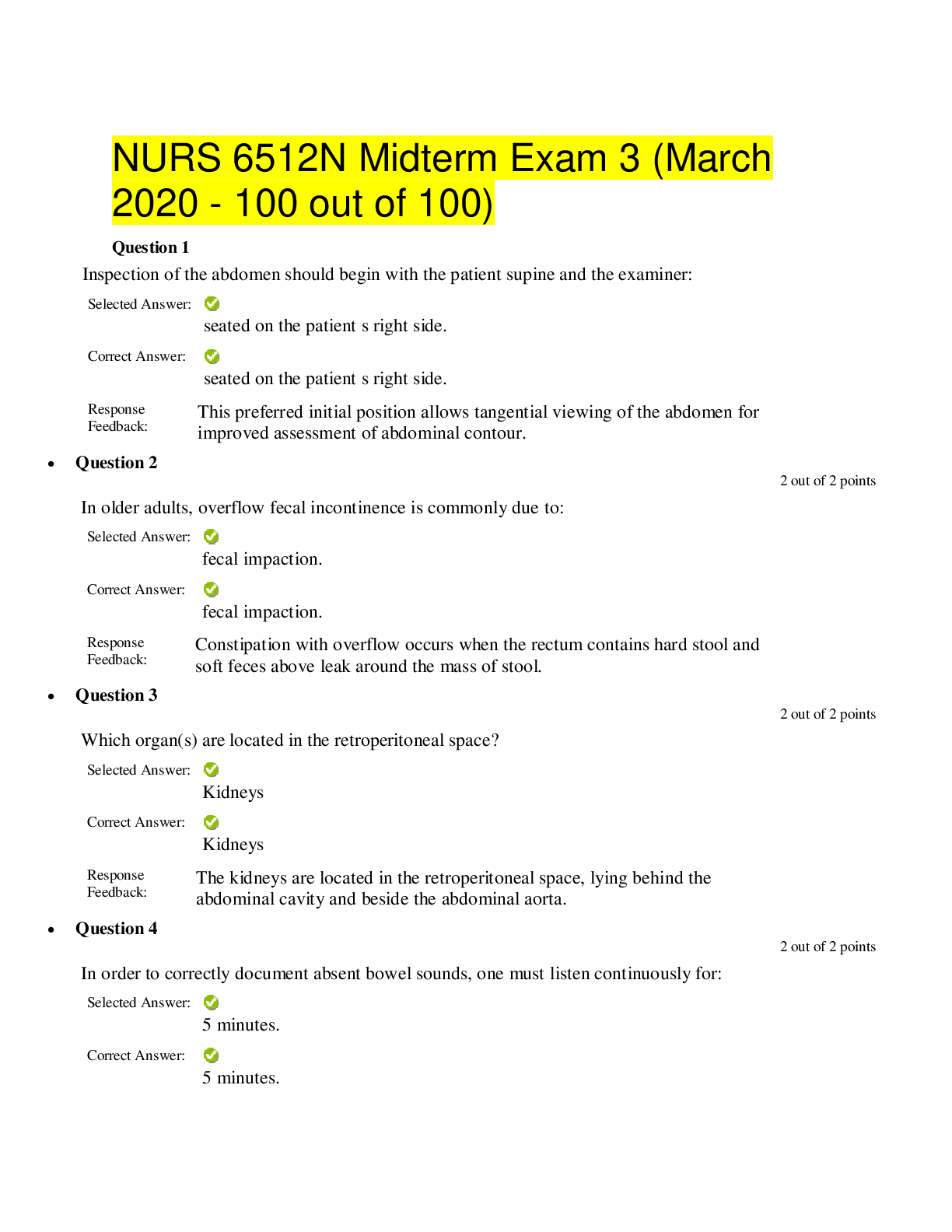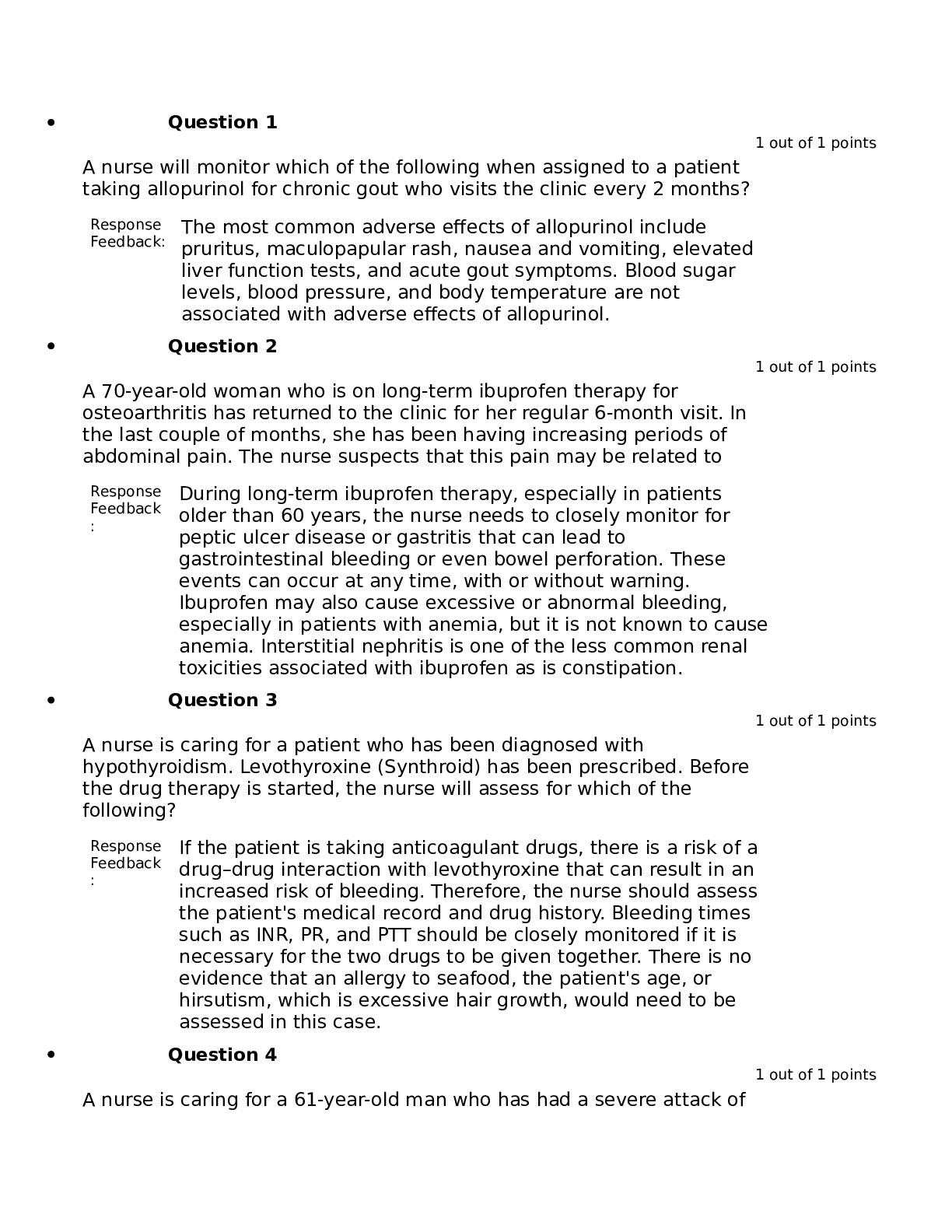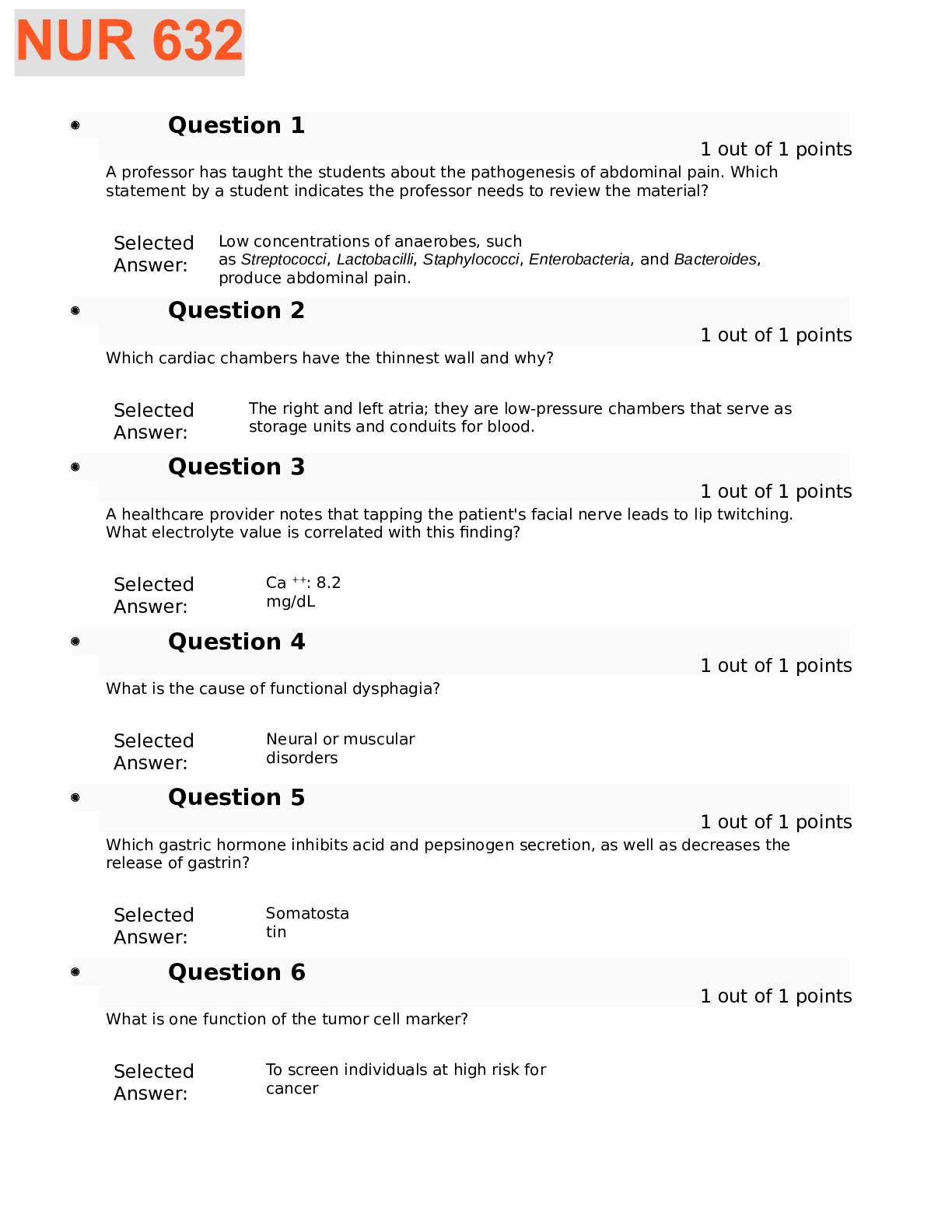BIOD 121 > EXAM > BIOD 121: Essentials in Nutrition Module 2 Exam (100 out of 100) Verified Answers (GRADED A) (All)
BIOD 121: Essentials in Nutrition Module 2 Exam (100 out of 100) Verified Answers (GRADED A)
Document Content and Description Below
Score for this quiz: 100 out of 100 MAKE SURE TO READ THE RED LETTERS FOR RIGHT ANSWERS!!! Multiple Choice: Which type of diffusion can move nutrients against the concentration from an ar... ea of low concentration to an area of high concentration? Facilitated diffusion Correct Answer Active transport Osmosis Passive diffusion List 3 organs of the gastrointestinal tract and state their functions. Your Answer: 1.) Mouth: Functions - The mouth can hold food also mechanically process food into the digestive system. 2.) Stomach: Functions - The stomach can hold a lot of food at once. The stomach mechanically and chemically processes food into the digestive system. 3.) Rectum: Functions - The rectum flows/passes food from the body that has been undigested. Mouth - hold and mechanically digests food Esophagus - passageway for food Stomach - Hold volume of food and mechanically and chemically digests it Small intestine - Site of digestion and absorption of nutrients Large intestine - Reabsorbs water and some vitamins Rectum - Passes undigested foodstuffs from the body List one of the GI tract’s accessory organs and its function for digestion. Your Answer: Options: Salivary glands: releases saliva containing enzymes that chemically digest food Liver – produces bile to break down fats Gallbladder – stores bile produced by the liver to be released into the intestine to digest fats Pancreas – releases digestive enzymes to chemically break down food True or False. If false explain why it is false. Intrinsic factor is the hormone responsible for controlling the concentration of acid in the stomach. Your Answer: True FALSE: Gastrin is the hormone responsible for controlling the concentration of acid in the stomach. OR Intrinsic factor is a vital glycoprotein produced in the stomach and is necessary for the B12 to be absorbed. Match the digestive disorder to its description or characteristics: Heartburn Constipation Diarrhea Irritable bowel syndrome Peptic ulcer List a dietary treatment for diverticulosis. Your Answer: A dietary treatment for diverticulosis is to add more fiber to your diet to promote healthy flow. Increase fiber intake List a treatment for ulcers/peptic ulcers. Your Answer: Medical treatments (antibiotics, drugs that block/reduce acid production, and protect lining of stomach) and lifestyle changes (decrease stress, stop smoking and avoiding foods that trigger symptoms) Multiple Choice: Which of the following is NOT True concerning blood sugar regulation? The pancreas influences blood sugar regulation Glucagon and insulin are responsible for blood glucose control Low blood sugar is called hyperglycemia Glucagon helps to raise blood sugar levels Excess glucose is stored as glycogen Multiple Choice: Which of the following is the storage form of glucose? fructose glycogen fiber monosaccharides disaccharides Match the sugar to its common source or characteristic: Fructose Lactose Maltose Sucrose Explain what digestive ailments can be addressed by (1) soluble and (2) insoluble fiber. Make sure to address how each type of fiber works in your answer. Your Answer: 1.) Soluble Fiber: soluble fiber lowers chloresterol as it supports satiety, controlling apetite. It can dissolve in water which creates an intestinal barrier, blocking absorbtion, slowing the glucose and fat. 2.) Insoluble Fiber: Can not dissolve inwater and cannot be broken down by bacteria like soluble fiber. Because of this, it can increase stool and increase the flow of stool passage through the large intestine. This can help constipation. • Soluble fiber slows glucose absorption and fat, so it’s associated with lowering cholesterol (and it provides satiety). Soluble fiber dissolves in water creating an intestinal barrier to block absorption. • Insoluble fiber can improve constipation. It does not dissolve in water and is not broken down by intestinal bacteria so it increases stool mass and speed of passage through the large intestine. Multiple Choice: Which of the following does amylase digest? Lactose Maltase Starch Cellulose Glucose Proteins provide kcal of energy/gram. Your Answer: 4 kcal 4 The process of gluconeogenesis is when the body converts into glucose for fuel. (select all that may apply): Protein Tissue Carbohydrate Lipid Ketones True or false. If false, explain why it is false. Low blood sugar levels are referred to as hypoglycemia. Your Answer: True True Compare and contrast type 1 and type 2 diabetes. Include cause, on-set, symptoms and treatment in your answer. Your Answer: Diabetes Type 1: Type 1 diabetes is usully developed in early stages in life like childhood or early adulthood. The pancreatic beta cells are destroyed which is the cause which secrete insulin. Symptoms include, excessive thirst, increase in apetite and weight loss. Treatment includes, healthier diet, exercises and insulin medication. Type 2: Type 2 diabetes is cause when the pancreas doesnt produce enough insulin or when the insulin is resisting. Poor diet or obiesity is the cause. Symptoms would be essessive thirst, increase in apetite and weight loss. Treamtent include healthier diet, exercises and oral medication. In both type 1 and 2 diabetes blood glucose levels are high, or there is hyperglycemia, so both also have similar symptoms (excessive thirst, urination, hunger, weight loss and ketosis). Causes, treatment and time of onset are different between type 1 and 2 diabetes: -Type 1 is when the pancreas doesn’t make any insulin, treatment is exogenous insulin and generally has onset in childhood-early adulthood and is rarer than type 2. -Type 2 is caused by insulin resistance or when the pancreas doesn’t produce enough insulin, treatment includes insulin and oral anti-diabetic drugs, it is linked to being overweight/diet, and generally has an onset in adulthood What is the difference between essential vs nonessential amino acids? Your Answer: Essential amino acids: There are 9 total that humans must add to their diet due to our bodies not being able to naturally produce them. Nonessential amino acids: There are eleven total. Can be produced by the body or getting from another source. Nonessential amino acids can be manufactured by the body or converted from other existing matter. There 11 are nonessential amino acids. Essential amino acids are 9 amino acids that we must consume through the diet as our bodies cannot naturally synthesize them. Match the following protein states to their definitions: Protein equilibrium Positive protein balance Negative protein balance You are advising a client who only eats a plant-based diet. How would you explain complete vs incomplete proteins and how would they make sure to have complementary proteins. Your Answer: Complete proteins are from animals flesh and products that contains amino acids. Incomplete proteins come from plants because there are essential amino acids missing, more than 1. To fulfill incomplete protein and to make it like complete, client must eat 2 incomplete proteins to have complementary proteins. Complete proteins are derived from animals and contain all essential amino acids. Other than a few exceptions, plants provide incomplete proteins where more than 1 essential amino acid is lacking. For someone on a plant-based diet, they need to consume a combination of at least 2 incomplete proteins. True or false. If false, explain why it is false. The type of fatty acid is dependent on the bonds that link the oxygen units together. Your Answer: Browser + Webcam False - links carbon units together, not oxygen. False: The type of fatty acid is dependent on the bonds that link the carbon units together. True or false. If false, explain why it is false. The ‘3’ and ‘6’ in omega 3 and omega 6 refer to the placement of the first carbon-carbon double bond. in the fatty acid. Your Answer: True True Match the term with this definition or description of structure. Lipoprotein Correct Answer Lipids surrounded by a shell of protein, phospholipids, and cholesterol Cholesterol Correct Answer A sterol that contains no glycerol backbone Monounsaturated fatty acid Correct Answer A fatty acid chain containing a single double bond between carbon atoms Polyunsaturated fatty acid Correct Answer A fatty acid chain with two or more carbon-carbon double bonds Describe why HDL is considered a marker of cardiovascular health. Explain where it is made, it’s main components and function in your answer. Your Answer: High-Density Lipoproteins (HDL) is considered a marker for cardiovascular health because Where HDL is made? - Main components and functions - Picks up chloresterol HDL is made primarily in the liver and is composed of protein. Thus it is a cholesterol scavenger, that picks up excess cholesterol and brings it to the liver for excretion and elimination. It’s a marker for cardiovascular health because it is associated with lower cholesterol and the protective effects of lower cholesterol on the cardiovascular system. Question 24 0 / 4 pts List at least 3 conditions that increase mortality risk for patients with metabolic syndrome. Your Answer: 1.) 2.) 3.) Diabetes, obesity, and cardiovascular disease You are volunteering with a medical relief group in a developing nation. A baby presents with edema in the legs and abdomen, mild weight loss, and his grandmother reports he is listless and fatigued. He was recently weaned and now obtains most of his calories from a powdered grain supplement. What type of malnutrition is he most likely suffering from? Your Answer: The type of malnutrition the baby is most likely suffering from is Kwashiorkor. Kwashiorkor True or false. If false, explain why it is false. Foods that are high in sugar are also good sources of fiber. Your Answer: Food that are high in startch are also good sources of fiber. FALSE: Foods that are often high in starch are good sources of fiber. For (A) insulin, and (B) glucagon, list the nutritional state of the body when the hormone is released, how each would influence the blood glucose levels, and by what mechanism. Your Answer: A.) Insulin • Fed state • B.) Glucagon: fasting state - causes breakdown of glycogen A. Insulin - the body would be in a fed state and insulin will work to increase cellular uptake of glucose to lower the blood glucose levels B. Glucagon - the body would be in a fasting state and glucagon will cause the breakdown of glycogen stores to increase blood glucose levels Jill says she considers herself a vegetarian, and you observe her eating a lunch with mashed potatoes, steamed broccoli and grilled salmon. What type of diet is this considered to be? Your Answer: Pescotarian pesco vegetarian Which macromolecule type plays a role in structural components, regulates body function, and enzyme production? Your Answer: The protein macromolecule type plays a role in structural components, regulates body function and enzyme production. Proteins [Show More]
Last updated: 1 year ago
Preview 1 out of 14 pages
Instant download

Buy this document to get the full access instantly
Instant Download Access after purchase
Add to cartInstant download
Reviews( 0 )
Document information
Connected school, study & course
About the document
Uploaded On
Jun 07, 2023
Number of pages
14
Written in
Additional information
This document has been written for:
Uploaded
Jun 07, 2023
Downloads
0
Views
44







.png)














.png)

